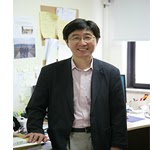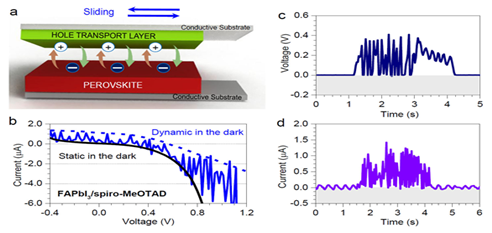The joint research team led by ChemE’s professor Nam Gyu Park and AMSE…
페이지 정보

본문
-The research team succeeded in the development of the world’s first direct current triboelectric nanogenerator by applying dynamic perovskite/CTL heterojunction
-The findings can be applied to the charging mechanism for mobile electronic devices and skin wound treatment, etc. in near future


[Figure 1] Prof. Sang-Woo Kim of AMSE and Prof. Nam Gyu Park of ChemE
AMSE Prof. Sang-woo Kim, as the corresponding author, and a M.S./Ph.D. combined course student Bosung Kim (co-lead author) developed the world’s first perovskite-based direct current (DC) triboelectric nanogenerator (TENG) in collaboration with Prof.Park Nam Gyu (corresponding author) of ChemE, Dr. Chunqing Ma (lead author).
The TENG converts mechanical energy from external sources into electrical energy through the contact-separation processes. Using micro-movement techniques in which generates electrical output, the TENG can be employed as an energy source for portable electronic devices and as a technology to treat skin wounds leveraging human body movements. Conventional triboelectrification entailed AC (alternating current) signals, which demands an external circuit that leads to the reduction of energy conversion efficiency with bulk system size.
Free electrons and holes generated by triboelectrification from the sliding motion can be transferred by the heterojunction, forming DC power output. The phenomenon was first identified by the joint research team led by Prof. Sang-Woo Kim and Prof. Nam Gyu Park.
Upon the contact and separating (Sliding) processes, the spiro’s organic hole conductor film placed on the perovskite semiconductor film produces negative and positive charges on the mutual interfaces. The charges migrate to form stable energy levels thermodynamically, resulting in electric current.

[Figure 2] Schematic device structure and output analysis. (a) Schematic illustration of the dynamic perovskite/hole transport layer (HTL) heterojunction device. (b) IV curves obtained from the dynamic sliding contact between the FAPbI3 perovskite and the spiro layers, along with static (no sliding movement) condition, measured in the dark (c) voltage and (d) current output of the dynamic perovskite/spiro heterojunction device under continuous sliding movements.
Conventional triboelectricity generates AC as the electric current changes along with the contact-separation direction. On the contrary, this triboelectricity follows the principle of charge separation in P/N junction; DC can be generated regardless of the direction of the contact-separation process. Furthermore, the research team demonstrated that light illumination and physical pressure act as stimuli to current output to a large extent.
“Dynamic halide perovskite heterojunction that generates DC doesn’t require rectifier to convert AC to DC; thus it can reduce the device size”, said Prof. Nam Gyu Park.
“The dynamic halide perovskite heterojunction will perform better than conventional AC triboelectricity when applied to wound treatment that requires micro-electric fields.”, Prof. Sang-woo Kim noted.
This work was supported by the National Research Foundation of Korea (NRF) grants funded by the Ministry of Science and ICT (MSIT) of Korea under contracts NRF-2016M3D1A1027663 and NRF-2016M3D1A1027664 (Future Materials Discovery Program) and NRF-2018R1A2A1A19021947 (the Basic Science Research Program). This research was in part supported by Energy Technology Program of the Korea Institute of Energy Technology Evaluation and Planning (KETEP), funded by the Ministry of Trade, Industry & Energy (No. 20193091010310).
※ Paper title: Dynamic halide perovskite heterojunction generates direct current
관련링크
댓글목록
등록된 댓글이 없습니다.


